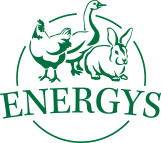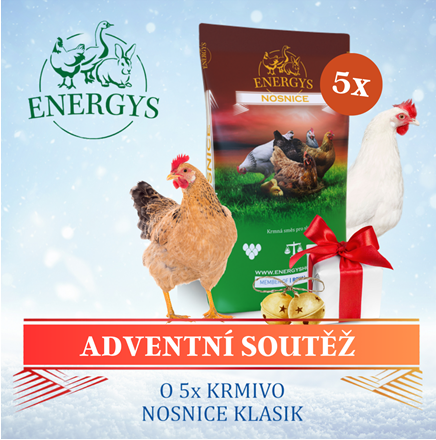Dam Pig breeds bred in the Czech Republic
Commercial pig breeders use both breeds that excel thanks to their reproduction parameters and breeds that pass on to their offspring good growth abilities, resilience and good meat quality. As a part of the hybridisation programme, the Pig Breeders Association and breeders work with dam breeds (Czech Improved White and Czech Landrace) and sire breeds.
Improved White (dam line)
The Improved White breed is the foundation stone for practically all world improvement and hybridisation programmes. In the Czech Republic, it accounts for the most numerous thoroughbred population that is used as a dam when crossing with the Landrace breed for the creation of sows in the F1 generation that are the mothers of meat pigs.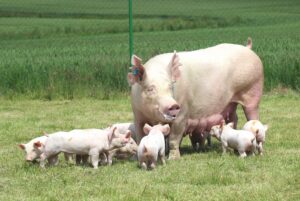
Improved White pigs have been bred in the Czech lands since 1926, when official checks on utility and hereditariness were introduced. Herd stabilisation was boosted by imports of, in particular, German improved pigs and Large White pigs from England. At the start, the breed was about reproductive utility and the exterior. The introduction of tests of actual utility lead to improvements in the composition of the meat torso with optimum representation of the meat parts and a reduction in the share of fat. When, as a part of the hybridisation programme applied in the 1980s, differential breeding started to be used, the Improved White pig was classified as a dam breed. The achievement of excellent reproductive abilities with a high number of viable and balanced piglets in litters was logically a primary requirement of breeding in the dam line. In addition, attention was paid to rapid growth and excellent conversion of feed with average muscle mass and meat utility.
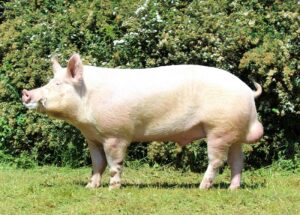 After 1989, there were a number of imports of Large White pigs in particular from England, Denmark, Sweden and France. Managing the breeding of pigs, including maintaining a breeding ledger, was the task of the Pig Breeders Association, which helped modernise the improvement programme. As a part of a programme that was launched on 1 January 1999, new improvement strategies were executed for the Improved White breed. They included integrating fertility into an estimate of breed value, the creation of super-fertile lines and a new approach to assessing the exterior.
After 1989, there were a number of imports of Large White pigs in particular from England, Denmark, Sweden and France. Managing the breeding of pigs, including maintaining a breeding ledger, was the task of the Pig Breeders Association, which helped modernise the improvement programme. As a part of a programme that was launched on 1 January 1999, new improvement strategies were executed for the Improved White breed. They included integrating fertility into an estimate of breed value, the creation of super-fertile lines and a new approach to assessing the exterior.
The aim of creating a super-fertile line was to accelerate the increase in fertility for the Improved White breed. In the selected population with the highest breeding value for fertility, the utility check was expanded to include other characteristics, such as individual birth weight, genotype in estrogen locus, the points value of sows’ dam characteristics and the length of labour in hours.
When selecting animals for breeding, preference was given to individuals with a large body frame, i.e. a sufficient withers height and appropriate length of the middle body. Another criterion was the mammary gland and the number of teats. In the case of a super-fertile line, the minimum number of teats on both sides is set at 8/8, which must be visible in both sexes. Great attention was paid also to the sexual expression of both sexes and, last but not least, the shaping and functionality of limbs, which are a predisposition factor for long life. With regard to the new direction in improvement, the Improved White breed started to be called Czech Improved White (CIW). Animals in the aforementioned breed stand out thanks to their large body frame, lighter head with straight ears, more delicate, but solid skeleton and solid constitution with a high degree of resistance to stress. Their skin and bristles are white. The dam lines excel thanks to their reproductive properties, excellent growth ability with very good nutrient conversion, optimum meat utility and good meat quality.
Landrace
Landrace is the second most widespread breed globally. It is a dam breed and this governs its improvement. Today,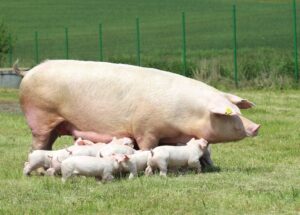 the main selection criteria is the number of surviving piglets, or rather the number of meat pigs sold. Practically all global improvement programmes deal with the balanced nature of a litter, piglet vitality and mother’s milk production. In addition to reproduction, a Landrace is require to have a large body frame with an appropriate length of the middle body. Good growth ability is a matter of course.
the main selection criteria is the number of surviving piglets, or rather the number of meat pigs sold. Practically all global improvement programmes deal with the balanced nature of a litter, piglet vitality and mother’s milk production. In addition to reproduction, a Landrace is require to have a large body frame with an appropriate length of the middle body. Good growth ability is a matter of course.
The basis of breeding Czech Landrace (CL) were thoroughbred pigs imported at the start of the 1960s from Poland, Canada, Germany, Sweden and later, in particular, Denmark and Norway. From the 1960s, the breed started to be successfully used for the creation of sows – crossbreeds in the F1 generation (with the Improved White breed) for production herds. As a part of the hybridisation programme, they are currently used as one of two basic dam breeds, which are required to have excellent reproductive properties with higher numbers of live-born piglets in litters and high growth intesity.
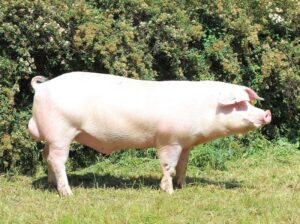 When there were quality defects with the meat (pale, soft, exudative meat – PSE) in the 1960s at slaughterhouses, it would found that this was a consequence of using stress-positive individuals (recessive homozygote in the halothane locus) in the breed. The halothane test was used to eliminate individuals with a tendency towards stress; it was successful and contributed to an improvement in the situation.
When there were quality defects with the meat (pale, soft, exudative meat – PSE) in the 1960s at slaughterhouses, it would found that this was a consequence of using stress-positive individuals (recessive homozygote in the halothane locus) in the breed. The halothane test was used to eliminate individuals with a tendency towards stress; it was successful and contributed to an improvement in the situation.
Pigs in the Czech Landrace breed have a larger body frame, a finer, but solid skeleton and a light head. Their ears droop and are reasonably long. They may have a more delicate constitution, but a solid and high degree of resistance to stress. Their skin and bristles are white. They have very good reproductive properties and high growth intensity with very good conversion of nutrients and meat utility.
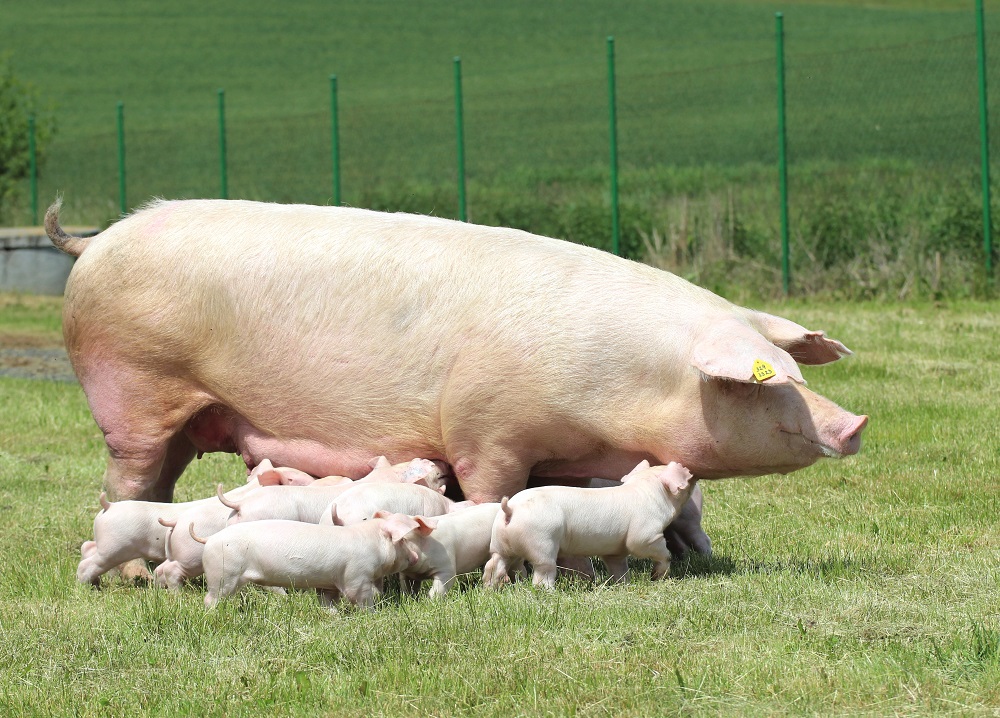
Související články
24. srpna 2021
V prosinci roku 2020 bylo v tuzemsku třiapadesát chovů prasat v režimu ekologického zemědělství. Na většině z nich chovají přeštická černostrakatá prasata, která jsou od roku 1992 zařazena mezi genetické zdroje. Podobně odolným a nenáročným plemenem jsou i maďarská kadeřavá prasata, jejichž obliba roste také u našich chovatelů.
25. května 2021
V České republice chovatelé pracují s otcovskými plemeny (v současné době reprezentované zejména bílým otcovským, durokem a pietrainem), včetně jejich syntetických linií (SL 34, SL 38, SL 48, případně SL 68), a s mateřskými plemeny prasat.
18. května 2021
V komerčních chovech prasat se využívají jak plemena, která vynikají reprodukčními parametry a mateřskými vlastnostmi, tak i plemena, která svému potomstvu předávají dobré růstové schopnosti, odolnost a dobrou kvalitu masa. V rámci hybridizačního programu Svazu chovatelů prasat, z.s., tak chovatelé pracují s mateřskými plemeny (v zastoupení české bílé ušlechtilé a česká landrase), a otcovskými plemeny.
19. června 2020
Zveřejnil: Tým Energys Hobby
K dosažení dobrého zdravotního stavu prasat je nezbytné, aby základem krmné dávky byla jadrná krmiva. Jejich výběr je limitován nejen možnostmi chovatele, ale i zvolenou alternativou hospodaření. Například v pravidlech ekologického zemědělství se vedle pestré skladby krmné dávky klade důraz na to, aby se zkrmovala v bio režimu vypěstovaná krmiva.
11. května 2020
Zveřejnil: Tým Energys Hobby
Z volného chovu se prasata postupně přesunula do uzavřených stájí, které se v komerčních chovech vyvinuly v sofistikované ustájovací kapacity využívající technologie nejen pro automatizované systémy krmení a napájení, ale i pro řízení stájového prostředí. V souvislosti s poptávkou po zdravých produktech od šťastných zvířat se však v Evropě již delší dobu prosazují trendy ekologického…
Související produkty
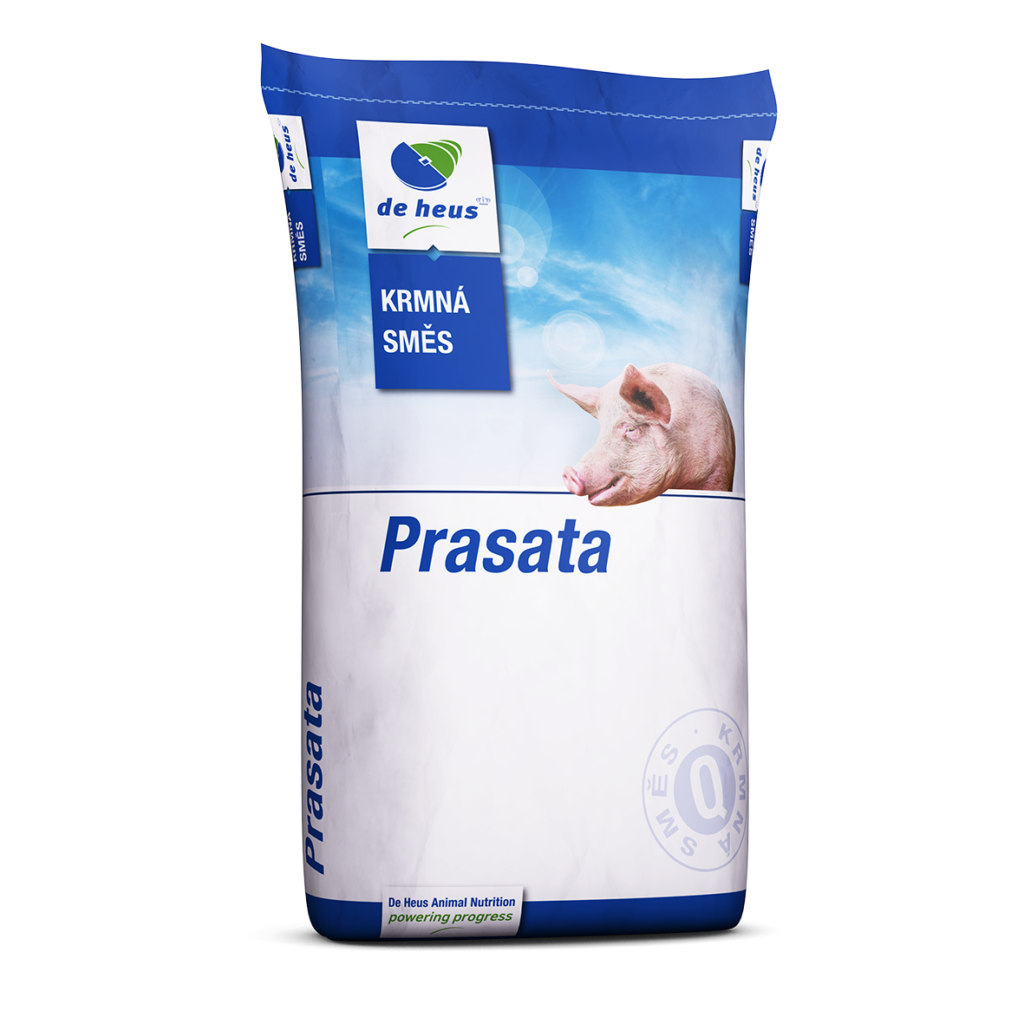
PIG UNI 15
Sypký univerzální koncentrát pro výkrm prasat, který se míchá s obilím dle fáze výkrmu v poměru 11 – 16 %. Je zárukou vysokých přírůstků.

KPK VITAL
Profesionální kompletní krmná směs pro kojící prasnice. Svým složením podporuje tvorbu mléka v potřebné kvalitě a množství.

KPB VITAL
Granulované kompletní krmivo pro jalové a březí prasnice zajišťující veškeré potřebné živiny. Granule 3,5 mm.

A3 MAXI
Kompletní krmná směs pro výkrm prasat nad 60 kg. Svým složením podporuje rychlý růst při nízké spotřebě krmiva během závěrečné fáze výkrmu. Granule 3,2 mm.

A2 MIDI
Kvalitní granule pro výkrm prasat od 35 do 60 kg. Vyváženost potřebných živin je základem pro výborný zdravotní stav, rychlý růst a vysokou zmasilost.

A1 MINI
Granulovaná krmná směs pro první fázi výkrmu prasat, tedy od 15 do 35 kg živé hmotnosti. Obsažené živiny podporují výborný zdravotní stav, rychlý růst a vysokou zmasilost Vašich prasat.
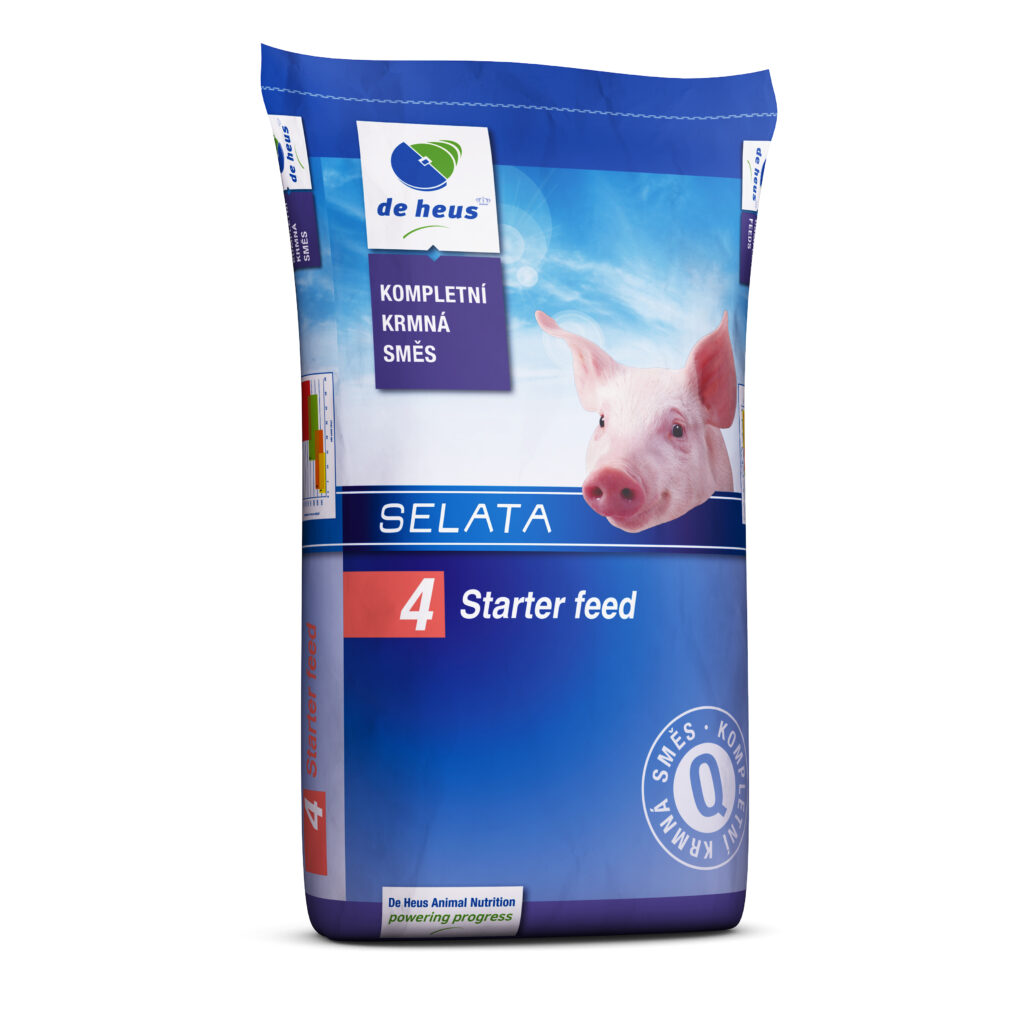
A1 START
Profesionální krmivo určené pro odstavená selata od 12 kg ž. hm. do 12. týdne věku. Ideálně nastartuje růst selat. Na toto krmivo se navazuje výkrmovou směsí A1 Mini nebo koncentrátem Pig UNI 15.
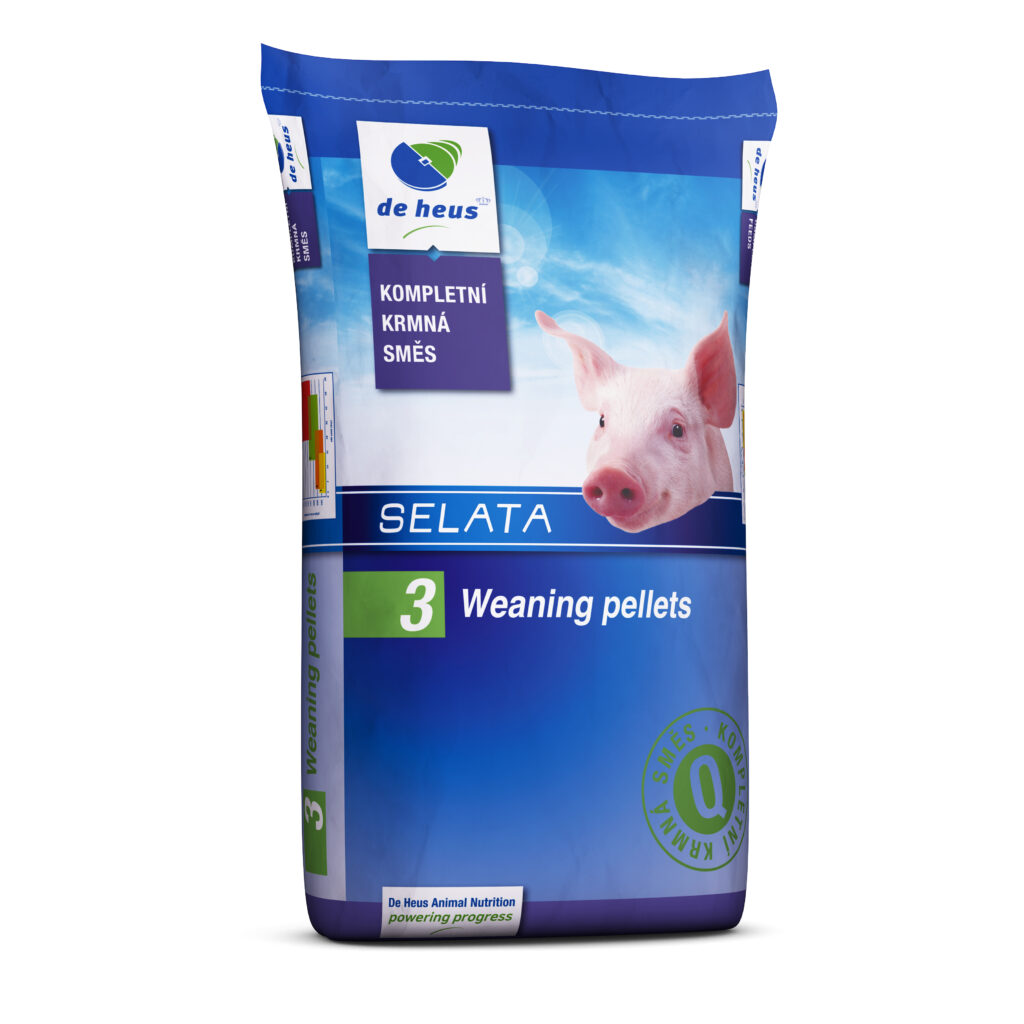
WEANING PELLETS
Prestarter pro selata od 10. dne věku do 14. dne po odstavu od prasnice. Struktura 2 mm granulí zajišťuje bezproblémový příjem a překonání odstavového období. Obsahuje mimo jiné syrovátku a rybí moučku, čímž zajišťuje rychlý růst selat.
